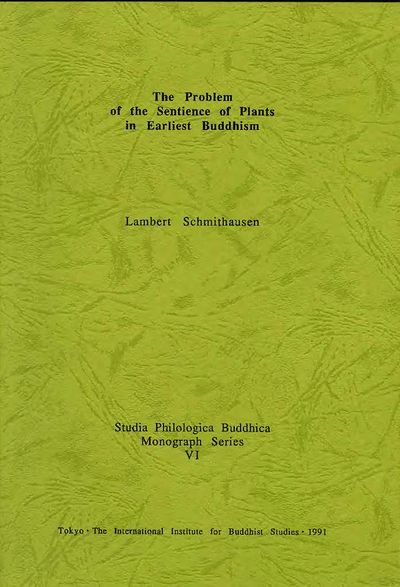In connection with the requirement of a non-anthropocentric ethics encompassing all creatures, or nature as a whole, the Buddhist precept - valid for monks and nuns as well as lay followers - to abstain from killing any living, animate being (pāṇātipātā veramaṇī), occasionally supplanted or supplemented by the injunction not to injure them (ahiṃaā), is no doubt very important. Even though in everyday practice the ideal is rarely fulfilled and although the present ecological situation has created additional complications, the precept does seem to have had some protective influence in at least some traditional Buddhist societies.
However, being a living or animate being (e.g. p(r)āṇa/p(r)āṇin, satt(v)a, jīva, bhūta) is, in India, at any rate in theoretical contexts, by and large equated with being sentient ((sa)cetana, sacittaka, cittamaṃta, etc.), with being, to a certain extent at least, capable of perception and sensation, and in doctrinally developed Buddhism it is, apart from men and mythological beings, only animals that are regarded as sentient beings. Except for certain developments
in the Far East and perhaps Tantric Buddhism (which requires special investigation), plants are not admitted in Buddhism as sentient beings, let alone crystals, stones, earth, water or other inorganic things. These are hence not, at least not directly, protected by the precept to abstain from killing/injuring animate beings.
The question is, however, whether this restriction of living, sentient beings, in the sphere of nature, to animals only was the position of Buddhism from the outset. Actually, from what we know about other Indian religions prior to or contemporary with earliest Buddhism, such a position would seem to have been anything but a matter of course.
As for Vedic religion, there is sufficient evidence that not only animals but also plants as well as seeds and even water and earth were, more or less naively, believed to be living and even sentient, and fire and wind had at least a personalized, divine aspect (viz. the gods Agni on the one hand, and Vāyu and Vāta on the other; cp. also the idea of water and fire as principles of life in late Vedic thought). Even in post-Vedic Hinduism, at least the view that plants and seeds capable of germination are sentient beings is still well documented, although some circles and authors disagree. Occasionally, even stones, water or the earth are admitted as living or sentient.
In Jainism the view that plants and seeds are sentient beings is clearly expressed and undisputed, and according to the view prevailing in Jaina sources even earth, water, wind and fire are alive, i.e., consist of minute living beings possessing, like plants, the sense of touch.
Against this background, it appears natural to raise the question whether in earliest Buddhism, too, at least plants and seeds (but perhaps even earth and water) may still have been viewed as living, sentient beings, in spite of the later rejection of such a view. To be sure, in this case it would be necessary to explain how the later view arose. But in the opposite case, too, one would have to search for a reason why the Buddhists, or the Buddha, abandoned the view, current at their time, that plants are sentient beings.
It would be easy to determine the status of plants and seeds in earliest Buddhism if the canonical Buddhist texts, and especially such layers as can be regarded as comparatively old, did contain fully explicit statements either rejecting or
asserting the sentience of plants. But there are none, as far as I can see. Hence, the matter has to be decided by induction. In view of the later doctrinal position of Buddhism that plants (etc.) are not sentient beings, the onus probandi is, of course, incumbent on him who maintains that in earliest Buddhism the situation was different. Therefore, I shall, in the following chapters (II-IV), discuss passages which may indicate that in earliest Buddhism plants were still regarded as living, sentient beings, or at least not yet definitely considered to be lifeless and insentient. (Schmithausen, The Problem of the Sentience of Plants in Earliest Buddhism, 1–4)
(*Notes of the author have been omitted.)

